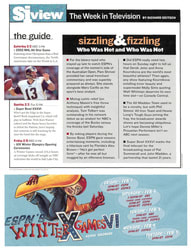
A Real HottieWhile others were doing a fast fade, indomitable JenniferCapriati took the heat at the Australian Open and refusedto wilt
A plate from Wimbledon. A cup from the U.S. Open. Three cups from
the Australian Open. Martina Hingis's quintet of Grand Slam
singles trophies--all acquired in a two-year window--have been
accumulating dust for three years. Their owner is an exquisite
player, but lately she has had no response to the power of
bigger, stronger opponents. Her confidence, once plated in armor,
has been fissuring. The conventional wisdom has been that at the
wizened age of 21, Hingis was finished as a Grand Slam threat.
Yet last Saturday in Melbourne, Hingis looked ready to add
another piece of silver to her collection. In the final of the
Australian Open she had a 6-4, 4-0 lead over a sluggish Jennifer
Capriati. Moments later Hingis held a match point. The pooh-bahs
at courtside straightened their ties for the trophy presentation
ceremony, and a television camera was wheeled onto the court,
ready to capture Hingis's rapture.
Not so fast. Capriati saw the camera out of the corner of her eye
and demanded that it be pushed back into a courtside tunnel. Then
she bludgeoned a backhand winner to stay in the match. Over the
next 25 minutes Capriati faced three more match points. Each time
she swung away with devil-may-care abandon, while Hingis's shots,
laced with hesitation, fluttered passively. "Even though the
score showed I was far behind," Capriati recalled, "I felt I was
right there in the match."
In conditions resembling a kiln--on-court temperatures reached
nearly 120[degrees]--Capriati won the second set in a
tiebreaker. During a 10-minute heat timeout between sets, both
players lay in the same air-conditioned training room, too
exhausted to speak, draped with ice packs and drinking
replenishing fluids. In the third set Hingis was physically
spent and psychologically wrecked by her staggering inability to
close out the match. "My head was all over the place," she
conceded. Capriati, meanwhile, said she had "something left in
reserve," the payoff for all those wind sprints and Tae Bo
sessions she has endured in the past year and the recently added
kick-boxing. After coasting to a 5-2 lead, Capriati punctuated
one of the most stunning comebacks in a Grand Slam final by
belting a forehand service return winner for a 4-6, 7-6, 6-2
victory.
A year after Capriati won the first major of her tortuous career
and established herself as a Comeback Kid for all time, her
unlikely narrative continues. Too fatigued to replicate her
victory dance of a year ago, she simply raised her arms in
triumph, betraying more relief than joy. However, as in 2001,
soon after leaving the court she phoned her brother, Steven, a
student at Arizona. Steven offered perhaps the highest praise a
brother can give a sister. "He just said I have more of a certain
something than he does," Jennifer recalled, laughing.
Capriati's astounding mettle--or, to be less charitable, Hingis's
astounding choke--salvaged an otherwise grim event. Unofficially
sponsored by Bengay and Ace bandages, the 2002 Australian Open
should have come with a surgeon general's warning. Before the
first point was played, Andre Agassi (right wrist injury), Serena
Williams (right ankle sprain) and Lindsay Davenport (knee
surgery) were out of the draw. Beset by tendinitis in her left
knee, Venus Williams was nearly immobile in the early rounds and
fell to Monica Seles in the quarterfinals. Recovering from
chicken pox, top men's seed Lleyton Hewitt got bounced in Round
1. Same for the slumping second seed, Gustavo Kuerten, hampered
by back and hip pain.
The rash of injuries was particularly troubling given that in
2001 both tours had reconfigured their schedules to extend the
off-season. The diagnoses varied. Organizers considered the
injury bug a fluke, "a one-off," as tournament director Paul
McNamee put it. Some implicated the rubberized Rebound Ace
surface, which gets sticky in heat. (When American Andy Roddick
reached for a ball during his second-round match, his shoe stuck
to the court like an insect on flypaper, and he turned his right
ankle, forcing him to retire.) Others cited the schedule change.
"Maybe it wasn't a long enough break," suggested Capriati. "Or
maybe it was too long, and everybody got out of shape."
One player unaffected by it all was Thomas Johansson of Sweden,
the surprise men's champion. Johansson, 26, played 28 sets and
was on court for nearly 18 hours, yet he hardly looked the worse
for it. He credited his stamina to an off-season spent playing
squash. "It's great for your movement," he said. He also got a
boost from an army of Swedish fans who exhorted him with
inspiring chants like, "Jobba Thomas, jobba pa, saft o bullar far
du da." Rough translation: "Keep working, Thomas. Then you will
get juice and sticky buns."
Johansson, the 16th seed, toils north of journeyman status, but
not by much. Before last weekend he'd won six titles in nine
years on tour and had never been past the quarterfinals of a
major. Nor is he among the game's more notable personalities.
"I'm not that interesting," he said. His tennis, though, was
arresting, a blend of powerful serving, efficient ball striking
and nifty shot making. In the final he played the match of his
life to beat No. 9 seed Marat Safin 3-6, 6-4, 6-4, 7-6.
Capriati, by contrast, never summoned her best tennis, which made
her title all the more impressive. Nursing a hip injury, she
advanced by dint of competitive resolve. "Getting into those
kinds of battles, I live for that," she said after needing a
second-set tiebreaker to beat Italy's Rita Grande in the fourth
round. "That's what I love about tennis."
When she steps onto the court, Capriati contracts a case of what
Aussies call "white-line fever," sublimating her usual affable
personality and turning into a fire-breathing dragon. When
successive calls went against her in the final, she appealed to
the chair umpire to remove the offending linesman, bellowing,
"Then call the f------ referee." Says Capriati's father and
coach, Stefano, "The way Jennifer plays, she says, This court is
mine."
In the past Capriati had been galvanized by a desire to show the
world that no, that girl with the raccoon eyes in the mug shot
isn't me. Now her motivation comes from wanting to prove that
2001, and her two majors, were no aberration. The phenomenon of
the Williams sisters might be tennis's driving force, but those
who dismiss Capriati as a one-off forget she has more of a
certain something than any other player on tour. That would be
heart, of course.
COLOR PHOTO: MARK DADSWELL/GETTY IMAGES (TOP) [T of C]
COLOR PHOTO: PHOTOGRAPH BY BOB MARTIN

